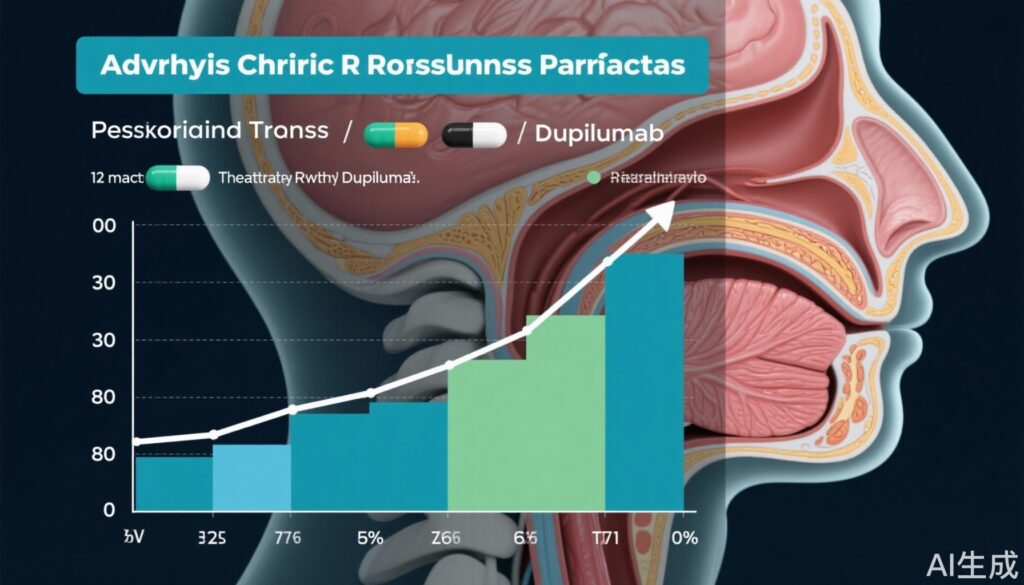Highlights
- Real-world data from 3318 patients with CRSwNP showed persistence with dupilumab at 84.9% and 69.5% at 6 and 12 months, respectively.
- Among patients who discontinued dupilumab, over 40% restarted treatment within 12 months, with a median reinitiation interval of 1.2 months.
- Adherence rate was high, with 75.2% of patients achieving a medication possession ratio ≥ 0.8 during the 12-month follow-up.
- Findings support sustained use and real-world effectiveness of dupilumab for CRSwNP and highlight the need for further study of persistence patterns in various patient subgroups.
Background
Chronic rhinosinusitis with nasal polyps (CRSwNP) is a persistent inflammatory condition characterized by polyp growth within nasal passages, significantly impairing quality of life through symptoms such as nasal obstruction, loss of smell, and recurrent sinus infections. Type 2 inflammation is a key pathogenic mechanism, and dupilumab, a monoclonal antibody targeting IL-4Rα to inhibit IL-4 and IL-13 signaling, has emerged as an efficacious biologic therapy for this population. Despite robust clinical trial evidence demonstrating dupilumab’s safety and efficacy, real-world treatment adherence and persistence data remain crucial to understanding its impact on long-term disease control outside controlled settings.
Key Content
Study Design and Patient Population
The referenced US claims-based retrospective cohort study analyzed 3318 patients with CRSwNP who initiated dupilumab therapy between June 2019 and December 2021. The study cohort had a mean age of 47.1 years and was predominantly male (54.4%). Researchers utilized pharmacy refill data and clinical claims to determine persistence and adherence metrics over an average follow-up of 375.6 days.
Definitions of Persistence and Adherence
Persistence was measured from the start of dupilumab until a 60-day lapse without medication refill or a switch to alternative CRSwNP-directed biologics (omalizumab or mepolizumab). Adherence was defined as having a medication possession ratio (MPR) ≥ 0.8 during 12 months post-initiation.
Persistence and Adherence Outcomes
Persistence rates were notably high: 84.9% at six months and 69.5% at one year. Among 913 patients who discontinued, 366 (40.1%) resumed dupilumab treatment after a median gap of 1.2 months. The probability of reinitiation was 35.5% at 6 months and increased to 43.3% at 12 months. Overall, 75.2% of patients met criteria for adherence, with a mean MPR exceeding 1.0, indicating consistent medication availability.
Comparisons to Other Biologics and Real-World Evidence
While omalizumab and mepolizumab are alternative biologics used for CRSwNP, this study suggests dupilumab maintains superior or comparable persistence and adherence in practice. Previous clinical trials (e.g., SINUS-24 and SINUS-52) reported high efficacy and safety profiles for dupilumab, and these real-world findings reinforce its role as a preferred biologic.
Implications for Clinical Practice
High persistence and adherence underscore dupilumab’s effectiveness in routine management of CRSwNP. The observed reinitiation rates after discontinuation suggest that temporary cessation may not preclude resumption of clinical benefit. Understanding patient factors influencing persistence, such as comorbid type 2 inflammatory diseases or aspirin-exacerbated respiratory disease (AERD), warrants further investigation to personalize treatment strategies.
Expert Commentary
This large real-world cohort study uniquely captures adherence and persistence dynamics of dupilumab in CRSwNP outside controlled trial settings, providing valuable evidence to clinicians. The methodology leveraging administrative claims data enables broad population insights but may lack granularity regarding clinical severity, patient-reported outcomes, and reasons for treatment discontinuation or resumption. Future research integrating clinical registries and patient surveys could elucidate these factors and optimize longitudinal management.
The high medication possession ratio suggests patient engagement and tolerability are favorable, complementing reported clinical improvements in nasal congestion, polyp size, and sense of smell from prior trials. Given the chronic nature of CRSwNP and the economic cost of biologics, these findings support continued efforts to improve access and adherence support interventions.
Expert guidelines increasingly recommend dupilumab as a first-line biologic for moderate-to-severe CRSwNP, especially when comorbid asthma or other Type 2 inflammatory conditions exist. Real-world persistence data further affirm its sustained effectiveness and may influence payer coverage policies.
Conclusion
Dupilumab demonstrates high persistence and adherence in a large real-world US cohort of patients with CRSwNP, with a significant proportion of those discontinuing promptly resuming treatment. These patterns affirm dupilumab as a viable long-term option for this challenging inflammatory disease. Expanded studies to explore treatment discontinuation reasons and persistence in key subgroups, including AERD and other Type 2 comorbidities, are needed to optimize patient outcomes.
References
- Pinto JM, et al. Real-world treatment patterns in patients with chronic rhinosinusitis with nasal polyps who initiated dupilumab: A US claims analysis. J Allergy Clin Immunol Glob. 2023;0(0):100557. DOI: 10.1016/j.jacig.2023.100557.
- Gevaert P, et al. Dupilumab efficacy and safety in moderate-to-severe nasal polyposis (SINUS-24 and SINUS-52): two multicentre, randomised, double-blind, placebo-controlled, parallel-group phase 3 trials. Lancet. 2020;396(10261):1638-1649.
- Fokkens WJ, et al. European Position Paper on Rhinosinusitis and Nasal Polyps 2020. Rhinology. 2020 Feb;58(Suppl S29):1-464.



